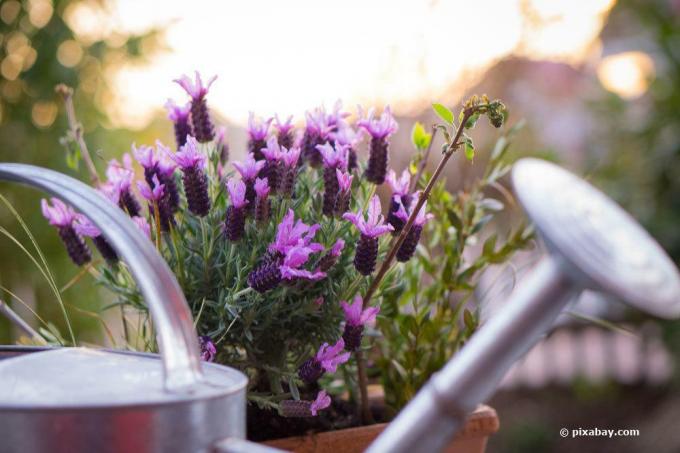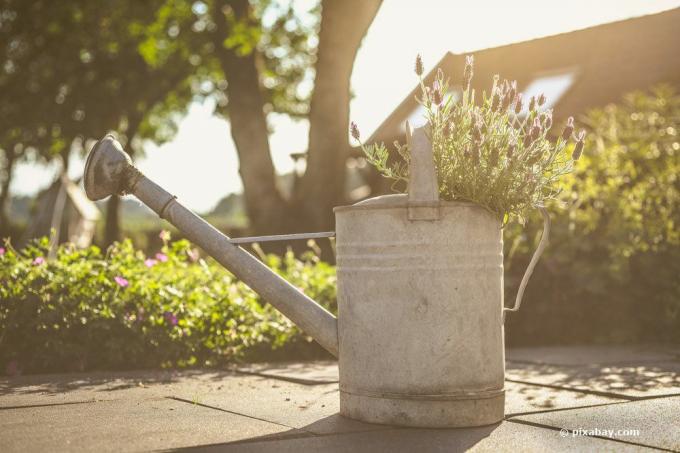
table of contents
- Care of potted lavender
- Location
- Substrate
- Repot
- to water
- Fertilize
- Cut
- Overwinter
- Multiply
- Diseases
- Buy preferred potted plants
lavender is one of the garden herbs that can be kept in pots without any problems. Lavandula angustifolia, the real lavender, is a robust plant with a characteristic scent that has been kept as a medicinal plant for centuries. In addition, the essential oils in the flowers are used to make perfumes at home. If you want to keep the labiates as a container or pot plant, there are a few things to consider that are fundamentally different from the care of the planted specimens.
Care of potted lavender
When planted out, lavender is an extremely undemanding plant and presents itself in the same way in the tub. Even if you repot your specimen before each winter, the need for care will not change and you can easily continue with care in the same way. Watering requires special care, as lavender is extremely sensitive to waterlogging. This is particularly important when it comes to keeping pots.
Location
The location for potted lavender differs only slightly from planted specimens. A Mediterranean climate can be made possible for the plant with the following properties:
- Light requirement: full sun
- warm
- protected
- South walls recommended
You don't need to worry about drought or too much sun with lavender plants. The Mediterranean plants prefer hot, dry locations and for this reason the warmth of a south wall is clearly recommended. In the house, on the other hand, she only feels at home in well-ventilated winter gardens. The real lavender likes to shrink on the windowsill, but with a lot of luck you can place it there as well. Make absolutely sure that there is no high humidity. Humid air is not ideal for the bushes.

tip: You can improve the vitality of your lavender if you protect it not only from strong winds but also from heavy downpours. The heavier the raindrops, the more Lavandula angustifolia suffers, as the plant does not tolerate too much moisture.
Substrate
The ideal substrate for lavender plants in pots should above all Waterlogging maintain. For this reason, the substrate must be lean and permeable, since waterlogging is not tolerated even for short periods of time. The following mixture has established itself for the mint family:
- Herb soil
- alternatively pricking earth
- Drainage layer: pebbles (fine), grit
The soil itself is not enriched with sand or the drainage agent, but used as a drainage layer at the bottom of the pot. Since herbal and pricking soil are extremely permeable and very low in nutrients, it is ideal for keeping Lavandula species.
Repot
Repotting the lavender is necessary for two reasons:
- a preferred potted plant was purchased
- the substrate is rooted
If you have just purchased a specimen, it is always advisable to repot, as the substrate used is only ideal for the plants in a few cases. It is also typical for lavender to root through the entire substrate after one, an average of two years. The more roots the plant forms, the larger the shrub becomes and, with ideal care, can reach sizes of 100 to 200 centimeters. The best time for this is spring, preferably in April, before the plants are moved outside from their winter quarters. Repotting is done in the following way:
- Spread the drainage layer on the bottom of the pot
- Spread a permeable garden fleece over it
- Half fill the pot with substrate
- Detach Lavandula angustifolia from the old substrate
- Shake off the soil from the roots
- Remove rotten, dried up roots
- use clean, sharp scissors for this
- put in fresh substrate
- fill up
- water sufficiently
The garden fleece is not necessary, but prevents the drainage layer from becoming clogged with soil and thus promoting possible waterlogging. The use of the garden fleece is particularly worthwhile for large specimens, as the soil can quickly sink into the drainage layer and thus lead to blockages. Don't forget that the pot must necessarily be over Vent holes should have.

tip: Keeping in pots also proves to be advantageous if the location of your planted specimens in the garden would be too damp over the winter. You can simply repot the medicinal herb in the same way as when repotting, transport it to the dry winter quarters and plant it out again the next year.
to water
The main thing to be careful about when pouring lavender in the pot is not to give too much water. Although the plant tolerates drought, this can quickly lead to a lack of moisture when kept in pots. The golden mean is in the foreground with lavender plants. This is how it works:
- Water only when the substrate is dry
- Check the substrate with a finger test
- pour carefully
- Pour away the water in the saucer after ten minutes
You can safely use tap water, as lavender plants need sufficient lime.
tip: To optimize drainage and to store heat, you can spread a layer of sand or decorative gravel in white color as a layer of mulch on the substrate. This supports the absorption of solar heat and ensures that the water does not get into the substrate too quickly.
Fertilize
Fertilization measures are definitely necessary for the sun worshiper Lavandula angustifolia, as the substrate is quite poor in nutrients. The fertilizers are administered exclusively from April to August, the main vegetation phase of the lavender, in a rhythm of four to six weeks. The following fertilizers are suitable:
- Compost in liquid form
- Herbal manure
- Worm tea
- organic fertilizers with high proportions of potassium
- Fertilizer sticks especially for lavender or alternatively olives
From mid-August you stop fertilizing, as from this time the plant slowly prepares for winter.
tip: Magnesium lime is a miracle cure for the vitality of lavender and should be administered once from April to August.
Cut
Lavandula angustifolia should regularly cut so that the plant does not become lignified and thus does not become weaker over the years. When it comes to pruning, the main thing is to keep the lavender young and stimulate it to flower. It is best to use two cuts a year, especially if you want to get a special shape or the shrub is too big. These pruning measures work as a preservation and pruning at the same time. The first time in the year is shortly before budding in spring at the end of March:
- use disinfected, sharp secateurs
- Shorten all shoots by about a third or two-thirds
- proceed evenly
- Completely remove sickly and dry shoots
The second cut of the year takes place after flowering from mid-July to early August. Proceed in the same way as for spring pruning, only shorten the shoots by a maximum of a third. Another cut after mid-August is not recommended, as otherwise the plant will not be able to sprout enough to survive the winter.

When cutting, always make sure that you never cut into the old wood, as the shrub will find it difficult to overcome such cut wounds. As a rule of thumb, there must be a pair of leaves on each shoot after the cut so that the lavender can continue to sprout.
tip: You should not discard the removed shoots in spring if you want to grow more lavender plants. Each individual shoot, as long as it is not dry or sickly, can be used as a cuttings for cultivation.
Overwinter
Hibernating the plant is quite easy. Since Lavandula angustifolia can withstand temperatures down to -25 ° C, only the pot itself needs to be protected from the cold:
- Place the vessel on the insulating pad
- Styrofoam or wood are ideal for this
- Pack the bucket
- use bubble wrap, garden fleece or jute sack for this
The plant is placed in front of a house wall, which protects against winds and precipitation. A south wall is also recommended here. Only water the plant on days without frost.
Multiply
Lavender plants are propagated over Cuttingsyou collect through the cut in spring. Cut these to a length of seven to ten centimeters and remove the leaves in the lower part and cut off the tip of the shoot to branch evenly enable. Then proceed as follows:
- Fill the seed tray with coarse sand and potting soil
- Ratio 1: 1
- Insert the cuttings vertically into the growing medium
- all leaves must look out of the earth
- Thoroughly spray cuttings with water
- Cover with foil or a plastic hood
The cuttings are now placed in a warm, bright place in the garden that is protected from the direct midday sun. The vessels are regularly ventilated and watered until the cuttings have developed roots by early summer. Then repot.

tip: A root hormone works very effectively with the lavender cuttings. Use it to treat the defoliated ends before sticking them into the substrate.
Diseases
Due to the essential oils it contains and its general robustness, lavender is not attacked by pests and does not suffer from diseases. In rare cases, however, stem rot, an infection by Phytophtora fungi, can occur. This is caused by Waterlogging in the pot. The stems of lavender become glassy when infected and then turn from gray-green to light brown before they die off completely. The entire plant perishes within two weeks. Only fungicides have become established for control.
Buy preferred potted plants
You can grow lavender yourself or buy it as a pre-grown potted plant in numerous hardware stores, florists and even in the supermarket. If you are interested in a specimen, you should definitely check the substrate for moisture. If this is permanently damp or even wet, you can expect that the plant will not survive long. You should also pay attention to whether the stems are glassy, gray or brown. In this case, the lavender plant suffers from a fungal infection and will perish within the next few days.
